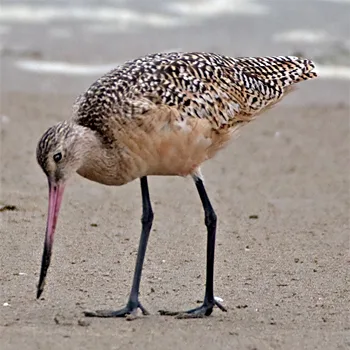
Marbled Godwit
[order] CHARADRIIFORMES | [family] Scolopacidae | [latin] Limosa fedoa | [UK] Marbled Godwit | [FR] Barge marbree | [DE] Marmorschnepfe | [ES] Aguja Canela | [NL] Marmergrutto
Subspecies
| Genus | Species | subspecies | Breeding Range | Breeding Range 2 | Non Breeding Range |
| Numenius | fedoa | ||||
| Limosa | fedoa | NA | c | s USA, MA | |
| Limosa | fedoa | beringiae | Alaska | w USA | |
| Limosa | fedoa | fedoa | c and sc Canada, nc USA | s USA to nw South America |
Physical charateristics
Godwits are large shorebirds with long, straight or slightly upturned bills. The rich, mottled buff-brown color identifies this species. The linings of the underwing are cinnamon.
Listen to the sound of Marbled Godwit
[audio:http://www.aviflevoland.nl/sounddb/M/Marbled Godwit.mp3]
Copyright remark: Most sounds derived from xeno-canto
| wingspan min.: | 79 | cm | wingspan max.: | 84 | cm |
| size min.: | 46 | cm | size max.: | 48 | cm |
| incubation min.: | 21 | days | incubation max.: | 23 | days |
| fledging min.: | 1 | days | fledging max.: | 1 | days |
| broods: | 1 | eggs min.: | 3 | ||
| eggs max.: | 5 |
Range
North America : Central
Habitat
Prairies, pools, shores, tide flats.
Breeds mostly on northern Great Plains, in areas of native prairie with marshes or ponds nearby. Localized populations also nest on tundra at James Bay, Ontario, and on Alaska Peninsula. During migration and in winter around tidal mudflats, marshes, pond
s, mainly in coastal regions.
Breeds mostly on northern Great Plains, in areas of native prairie with marshes or ponds nearby. Localized populations also nest on tundra at James Bay, Ontario, and on Alaska Peninsula. During migration and in winter around tidal mudflats, marshes, pond
s, mainly in coastal regions.
Reproduction
May nest in loose colonies. Male displays over breeding territory by flying over area, calling loudly. On ground, members of pair may go through ritualized nest-scrape-making display.
Nest: Site is on ground, usually in short grass on dry spot fairly close to water (sometimes far from water). Nest is slight depression, lined with dry grass. Occasionally has slight canopy of grass arranged above nest.
Eggs: 4, rarely 3-5. Greenish to olive-buff, lightly spotted with brown. Incubation is probably by both parents, 21-23 days. Incubating bird may sit motionless even when approached closely.
Young: Downy young leave nest soon after hatching. Both parents tend young, but young find all their own food. Age of young at first flight roughly 3 weeks.
Nest: Site is on ground, usually in short grass on dry spot fairly close to water (sometimes far from water). Nest is slight depression, lined with dry grass. Occasionally has slight canopy of grass arranged above nest.
Eggs: 4, rarely 3-5. Greenish to olive-buff, lightly spotted with brown. Incubation is probably by both parents, 21-23 days. Incubating bird may sit motionless even when approached closely.
Young: Downy young leave nest soon after hatching. Both parents tend young, but young find all their own food. Age of young at first flight roughly 3 weeks.
Feeding habits
Includes insects, mollusks, crustaceans. In summer on prairies,
feeds mostly on insects, including many grasshoppers; also roots and seeds of various aquatic plants, such as sedges and pondweeds. On coast, feeds on mollusks, marine worms, crustaceans, other invertebrates.
Behavior:
On mudflats and in marshes, forages mostly by probing in water or mud with long bill. Often wades and probes so deeply that head is underwater. Finds most food by touch; may feed by day or night. On prairies, also picks up insects from surface of ground
or plants.
feeds mostly on insects, including many grasshoppers; also roots and seeds of various aquatic plants, such as sedges and pondweeds. On coast, feeds on mollusks, marine worms, crustaceans, other invertebrates.
Behavior:
On mudflats and in marshes, forages mostly by probing in water or mud with long bill. Often wades and probes so deeply that head is underwater. Finds most food by touch; may feed by day or night. On prairies, also picks up insects from surface of ground
or plants.
Conservation
This species has an extremely large range, and hence does not approach the thresholds for Vulnerable under the range size criterion (Extent of Occurrence <20,000 km2 combined with a declining or fluctuating range size, habitat extent/quality, or population size and a small number of locations or severe fragmentation). Despite the fact that the population trend appears to be decreasing, the decline is not believed to be sufficiently rapid to approach the thresholds for Vulnerable under the population trend criterion (>30% decline over ten years or three generations). The population size is very large, and hence does not approach the thresholds for Vulnerable under the population size criterion (<10,000 mature individuals with a continuing decline estimated to be >10% in ten years or three generations, or with a specified population structure). For these reasons the species is evaluated as Least Concern.

Migration
Northern Great Plains; locally southwestern Alaska. Winters southern United States to northern South America. Migration: Migrates in flocks. Most birds mo
ve to coastal regions in winter. Some reach South America, but most winter north of Panama. A few birds (possibly one-year-olds) remain on winter range throughout the summer.
ve to coastal regions in winter. Some reach South America, but most winter north of Panama. A few birds (possibly one-year-olds) remain on winter range throughout the summer.
Distribution map

